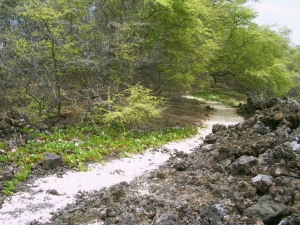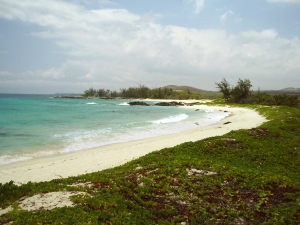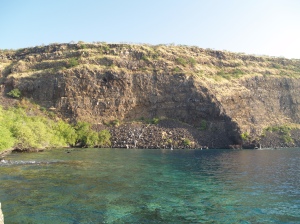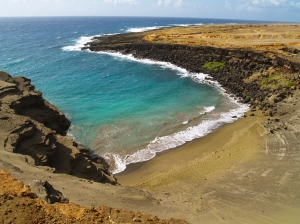Hawaiian place names have meanings that are as poetic as their pronunciations are lyrical. "Makalawena" for instance, the name of a beach near the middle of Kekahakai State park, means "mischievous winds". Hawaiian canoe sailors, and modern day navigators, know the region around Makalawena Beach and the cinder cone, Pu'u Ku'ili, to be a gusty place of locally unpredictable winds.
It is said of this region that the God of Wind, La'amaomao, so annoyed the other gods on the Kona Coast that one day they surrounded her and cut off her nose, tossing it on the shore by Makawena Beach. La'amaomao's nose thus became Pu'u Ku'ili. Now, the wind god no longer troubles the other gods but the mischievous winds of La'amaomao still play around Pu'u Ku'ili and Makalawena.

Makawena Beach is one of the last wilderness beaches in all of Polynesia you can back-pack into. It is a delightful place, usually empty, always uncrowded. Occasionally boisterous locals take it over on weekends so it's best to camp there during the week. This beach, frankly the finest swimming and snorkeling beach on the island, is also easily the most beautiful, sporting a series of coves, refreshing shade, big sand dunes and a nice freshwater pond to rinse-off in.
Overnight camping on Hawaii beaches in general, and at Makalawena in particular, is simplified because of the mild climate--usually I just take a few quarts of water, a couple sandwiches, my camera, dry clothes for post-snorkeling comfort, a fleece blanket (a dry beach towel will suffice) and rice mat to sleep on and a small tarp on the off-chance it rains. The key here is that if the weather turns truly ugly, you are no more than twenty minutes from your car. You may wish to bring a few extra quarts of water to rinse the salt off after bathing--many people find it difficult to sleep with salty skin.

However, in truth, you are so close to the parking lot, and the trail is so flat and easy, that you can bring just about anything you can carry in--just be sure to take back out everything you brought. On these delicate and beautiful beaches it is imperative to practice good backcountry skills and leave no trace. Fires are illegal on these beaches as is hacking down the few trees and bushes to make shelter; even if it wasn't illegal, it would be immoral in the extreme to wreak such havoc and destruction on the last of Polynesia's superb, wilderness beaches.
There is a band of wild goats that inhabit the area and use the local springs for watering. Usually they evince little curiosity about, or fear of, visiting humans. However, they are wild and they are big and they are ornery--you are best to keep your distance, do not harass or try to feed them. This includes your garbage management, as garbage will attract them, too. Mongooses can also be a problem, raiding your garbage and food supply. Like all desert animals, the goats and mongooses are hungry for salt and have been known to steal and eat sweaty hiking shoes, t-shirts and socks. Keep a clean campsite, keep your garbage tightly bagged and you should have no problem. Remember La'amaomao and the Makalawena winds…keep things tidy.

Right now no fees or permits are required to camp on Makalawena Beach, but this may be about to change. Be sure to check with the Hawaii State Department of Land and Natural Resources as you plan your trip.
To reach Makalawena Beach, turn off Highway 19 just south of Mile Marker 90 at Kekahakai State Park and drive all the way to the parking lot. This road is open Thursday through Tuesday 9 a.m. to 7 p.m.; after hours it is locked at the highway entrance. Do not risk getting locked onto this road a night--it’s a long walk back to Kailua. The road into Kekahakai is notoriously rough; taken very slowly most vehicles can pass, but forewarned is fore-armed.

An obvious trail leads north from the parking lot along an old carriage road to the abandoned Magoon Mansion on Mahaiula Beach. At the mansion, the trail runs to the beach then through a copse of keawe trees past some springs and over the a'a lava field to the beach dunes. Since this trail goes over rough pahoehoe and a’a and through keawe breaks, shoes are required--no flip-flops.
The land fronting the beach is owned by Bishop Estate/Kamehameha Schools and is slated to be turned into a development of condos and resorts; vigilance and protest on the part of locals and visitors is the only way we can keep this last, wild Kona beach wild.
Go--enjoy the solitude and don't forget your camera. Whale, dolphin, gorgeous scenery and Kona's famous sunsets await your shutter. A quick hike to the top of La'amaomao's nose, Pu'u Ku'ili, is a wonderful place for pictures, panoramic views of the Kona coast and sunset. An overnight camping trip--even a day hike--to Makalawena Beach is bound to be a highpoint of anybody's Big Island adventure.

For more information on traveling to Hawaii in general and hiking and camping on the Big Island in particular, please visit www.tourguidehawaii.com and www.lovingthebigisland.wordpress.com.




